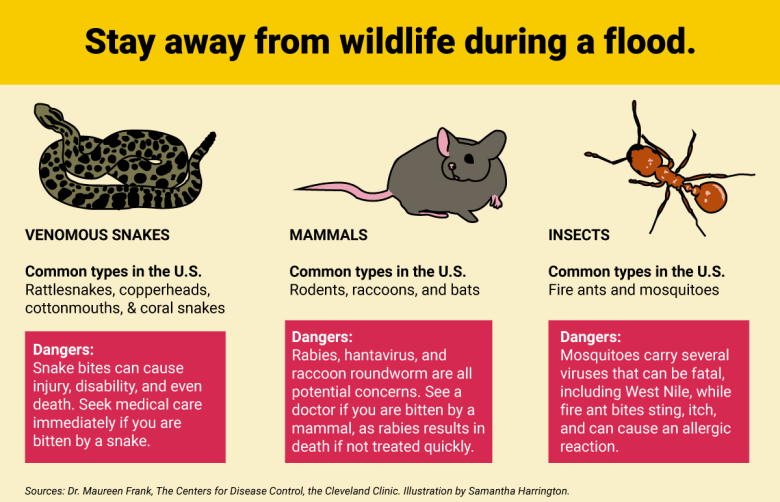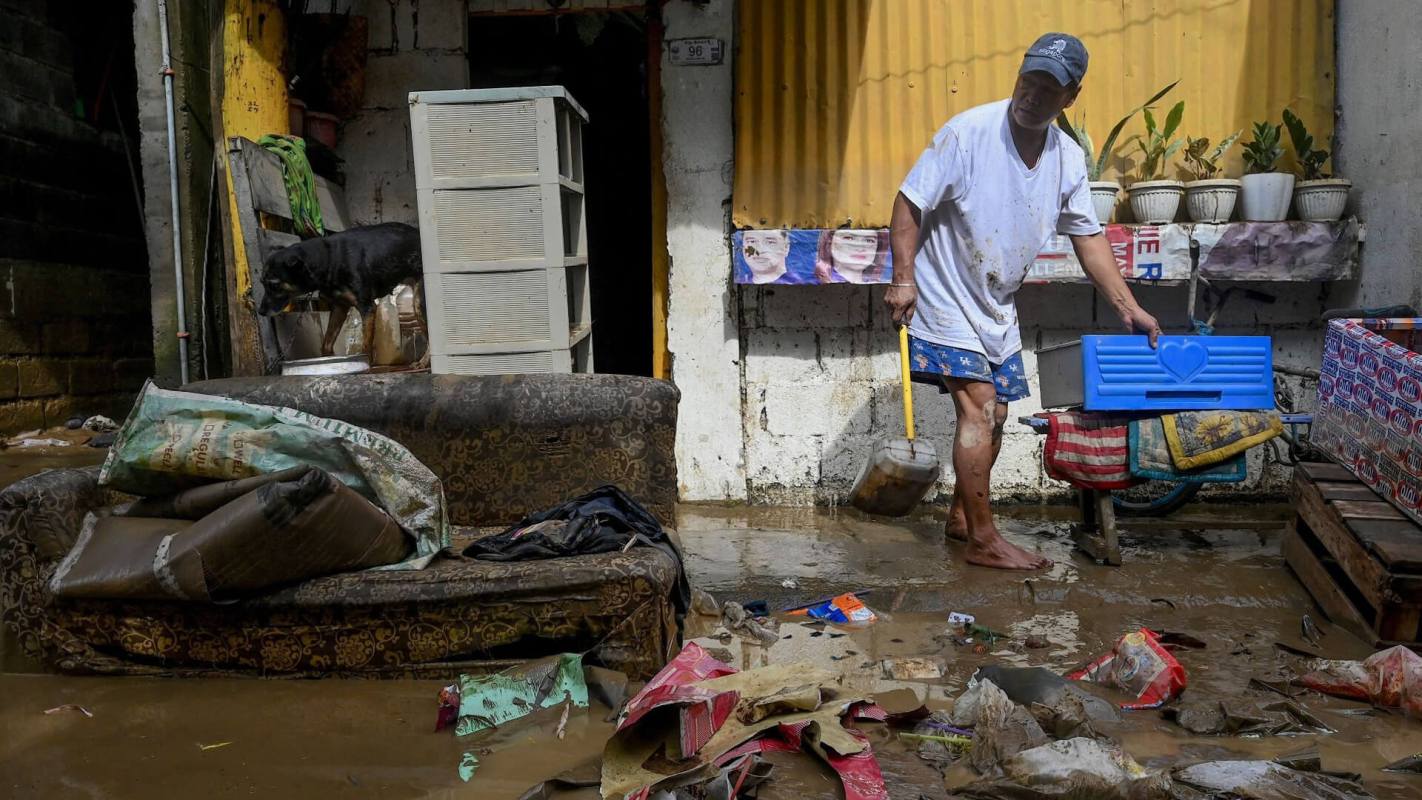My family doesn't remember how old I was when I almost drowned in a stormwater retention pond after a flood. My dad guesses I was between the ages of 7 and 9.
What I do remember is that after a heavy rainstorm, water pooled in the park, turning a grassy ditch into a small lake. The neighborhood kids splashed in puddles and waded into the temporary pond. A boy from my class at school called to me: "Come stand right here, the water's warm!" The next thing I remember is a rush of water sucking my leg into the culvert that drained the pond. My classmate held my head above water so I could breathe while someone ran for help.
My dad pulled me out of the pond, scraped up but otherwise fine.
I was lucky.
In the United States, an average of 88 people drown in floods each year, according to the National Weather Service. Drowning isn't the only risk associated with exposure to flood waters. People also contract diseases, get bitten by snakes and other wild animals, and get electrocuted during and after floods.
As climate change increases the intensity of rain storms and rising sea levels, more people are expected to come into contact with flood waters. One 2022 study found a "locked in" increase of 26.4% in U.S. flood risk by 2050.
In this case, "locked in" means that the increase in flooding is expected regardless of present or future efforts to slow climate change.
The study authors also project that increases in flood risk will be felt the hardest in communities on the coast with high numbers of Black residents. People living in Texas and Florida will see about a 50% increase in flood exposure by 2050. Additionally, areas with a high percentage of Black community members will see the greatest risk increase, while census tracts with the lowest proportion of Black residents will see "very little increase" in their flood risk.
How to stay safe during a flood
If your area floods, do what you can to avoid touching, consuming, or driving into the water. In some instances, like emergency evacuations and water rescues, it's impossible to avoid the flood waters altogether. So in those cases, try to wear protective clothing like boots, gloves, and a life jacket.
Why you should stay out of flood waters:
You don't know how deep the water is, how fast it's moving, or what kind of debris may be in it.
Many flood-related deaths are preventable and result from driving into or walking in or near flood waters, according to the National Weather Service. It can be difficult to tell how quickly water is moving or how deep it is from afar. Roads underneath flood waters may have collapsed, making the water much deeper than drivers may expect.
The National Weather Service campaign, "Turn Around Don't Drown," aims to raise awareness and keep people safe during flooding. It only takes six inches of fast-moving water to knock over an adult, 12 inches to carry away most cars, and two feet to carry away SUVs and trucks, according to the campaign.
Fast-moving water also may contain dangerous, submerged debris like tree limbs and glass and metal fragments. Those objects can injure people walking in flood waters or puncture tires on vehicles.

Flood waters are usually contaminated, and exposure could make you sick.
Exposure to flood waters increases your risk of contracting a waterborne disease. Flooding can overwhelm sewage and septic systems and stir up pathogens in soil so that mere contact with the water can cause disease.
Joan Rose, who studies water at Michigan State University, says that bacteria, protozoa, and viruses that can harm human health can all be found in flood water: "Wherever the water moves, these organisms move with them."
One of the most common pathways by which waterborne diseases are spread is getting contaminated water on your hands or drinking it. Common pathogens, such as E. coli, shigella, and giardia, all spread this way. Other diseases, like vibriosis, can infect you when germs come in contact with your skin.
Rose says that it's important to pay attention to information from your local government about water safety and to take any boil orders seriously. Boiling kills pathogens in water.
In addition to germs, dangerous chemicals from household, medical, and industrial sites are frequently present in flood waters, the Centers for Disease Control and Prevention cautions. In areas where coal ash — the residual product of burning coal — is common, that waste can spread carcinogenic compounds, like arsenic and mercury, into the water.
If you notice any symptoms of illness — like gastrointestinal or respiratory issues or eye infections — during or after exposure to flood water, seek medical care. Letting a doctor know about your exposure can help in ensuring needed care for you and your community. Evidence of waterborne disease transmission is shared with public health officials as they strive to keep your community safe.
"People should be aware that these kinds of things happen with flooding, and it's not just a little bit of diarrhea," Rose advised. "A little bit of diarrhea could turn into something else down the road from some of these pathogens."
Downed power lines in the water could electrocute you.
Power lines, electrical cords, and outlets can all electrify water, making it very dangerous. Water conducts electricity well, and contact with flood waters can lead to electrocution. Never drive in or approach water that contains downed power lines.
If your home floods, turn off the power by switching off the main breaker in your home's electrical panel. Make sure that you are not standing in water when you turn the power off. Don't turn it back on until an electrician can assess it for safety, the CDC advises.
If someone has been electrocuted, call 911 immediately. The CDC recommends that people avoid touching the shocked person — who may still be in contact with the electrical current — as such contact could lead to your also being electrocuted. If you are able, turn off the power and check the shocked person's pulse. If it has stopped or seems slow, perform CPR until emergency support arrives.
You may encounter wild animals that could injure or spread disease to you.
Interactions with wild animals during floods can also be dangerous. During a flood, wild animals search for safe ground. The most common dangerous animals you might encounter during a flood are snakes, fire ants, and mammals — like rodents, raccoons, and bats — according to Maureen Frank, associate professor and extension wildlife specialist at Texas A&M AgriLife Extension.
If you see a wild animal during a flood, keep your distance. Frank says most animals are adapted to deal with flooding on their own and won't need your help. If you do see an injured animal, you should contact a licensed professional right away. Many states regulate what you can and cannot do to help a wild animal, so don't try to take care of it on your own. Experts can often be found through your state's fish and game or parks and wildlife departments, Frank says.
Animals may seek shelter in debris piles, so when you're moving around during a flood or during clean up, always wear protective gear and be careful where you walk. "Don't put your hands and feet in places where you can't see what might be there," Frank said.
Frank also said that it's important to be aware of the kinds of animals that live in your area. In Texas, for example, home to 12 different kinds of venomous snakes, you should familiarize yourself with local fauna and snakes well before a flood occurs. If you are bitten by a snake or other animal, call a medical professional and describe what the animal looked like in as much detail as you can.

After a flood, clean your home
When the danger of rushing water has passed, you still need to be careful. After a flood, Rose recommends you clean your home with a bleach solution, particularly areas where you'll be preparing food. Additionally, avoid eating any food that may have been contaminated.
If you have cuts or wounds that were exposed to flood waters, be sure to clean them with antibacterial ointment.
If your home suffered structural damage, Frank recommends sealing up any holes that animals could fit through and removing debris piles as soon as possible. The longer debris lingers, the more likely that snakes or rodents are to turn the piles into their homes.T
his article was written by Samantha Harrington and originally appeared on Yale Climate Connections.
Follow The Cool Down on Instagram and subscribe to our newsletter.








